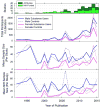Sex disparities in substance abuse research: Evaluating 23 years of structural neuroimaging studies
- PMID: 28212516
- PMCID: PMC5581940
- DOI: 10.1016/j.drugalcdep.2016.12.019
Sex disparities in substance abuse research: Evaluating 23 years of structural neuroimaging studies
Abstract
Background: Sex differences in brain structure and clinical course of substance use disorders underscores the need to include women in structural brain imaging studies. The NIH has supported the need for research to address sex differences. We evaluated female enrollment in substance abuse structural brain imaging research and the methods used to study sex differences in substance effects.
Methods: Structural brain imaging studies published through 2016 (n=230) were evaluated for number of participants by sex and substance use status and methods used to evaluate sex differences. Temporal trends in the numbers of participants by sex and substance use status were analyzed. We evaluated how often sex effects were appropriately analyzed and the proportion of studies that found sex by substance interactions on volumetric measures.
Results: Female enrollment increased over time, but remained significantly lower than male enrollment (p=0.01), with the greatest bias for alcohol and opiate studies. 79% of studies included both sexes; however, 74% did not evaluate sex effects or used an analytic approach that precluded detection of sex by substance use interactions. 85% of studies that stratified by sex reported different substance effects on brain volumes. Only 33% of studies examining two-way interactions found significant interactions, highlighting that many studies were underpowered to detect interactions.
Conclusions: Although female participation in substance use studies of brain morphometry has increased, sex disparity persists. Studying adequate numbers of both sexes and employing correct analytic approaches is critical for understanding sex differences in brain morphometric changes in substance abuse.
Keywords: Female inclusion; Grey matter volume; Sexual dimorphism; Structural brain imaging; Substance abuse.
Copyright © 2017 Elsevier B.V. All rights reserved.
Conflict of interest statement
No conflicts declared.
Figures




Comment in
-
Corrigendum to Sex disparities in substance abuse research: Evaluating 23 years of structural neuroimaging studies [Drug Alcohol Depend. 173 (2017) 92-98].Drug Alcohol Depend. 2017 Jul 1;176:181-184. doi: 10.1016/j.drugalcdep.2017.04.002. Epub 2017 May 6. Drug Alcohol Depend. 2017. PMID: 28483488 No abstract available.
References
-
- Agresti A, Coull BA. Approximate Is Better than “Exact” for Interval Estimation of Binomial Proportions. Am Stat. 1998;52:119–126. doi: 10.2307/2685469. - DOI
Publication types
MeSH terms
Grants and funding
LinkOut - more resources
Full Text Sources
Other Literature Sources
Medical

